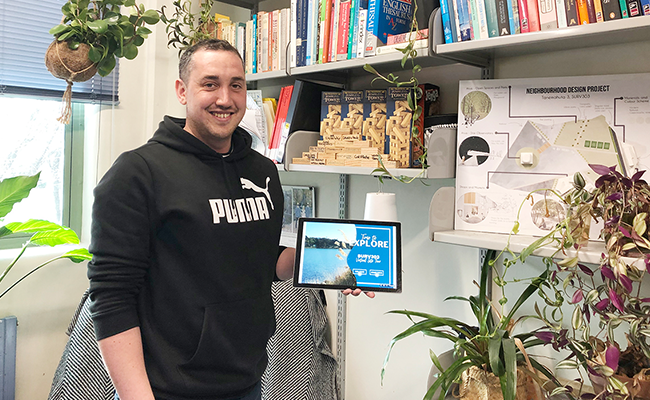 Dr James Berghan (Te Rarawa, Te Aupōuri) has received a 2022 Curriculum Innovation award for exemplary courses from the Lincoln Institute of Land Policy.
Dr James Berghan (Te Rarawa, Te Aupōuri) has received a 2022 Curriculum Innovation award for exemplary courses from the Lincoln Institute of Land Policy.
For an innovative researcher and teacher like Dr James Berghan (Te Rarawa, Te Aupōuri), of Te Kura Kairūri School of Surveying, the challenges of two years dominated by a pandemic have fortunately come with a silver lining.
The University of Otago researcher has received a 2022 Curriculum Innovation award for exemplary courses from the Lincoln Institute of Land Policy for his innovative teaching practices in a third-year urban design paper.
Only four awards, worth US$7,000 each, are offered annually from the United States-based non-profit organisation, and this year Dr Berghan joins recipients from prestigious American universities including the University of Michigan and Arizona State University.
“I was absolutely rapt when I heard the outcome, and as I'm particularly interested in teaching and research methods, having my teaching practices validated in this way is fantastic recognition.”
Dr Berghan says he had a moment when putting the application together wondering how his entry from this “little corner of the world” would rate.
“I was absolutely rapt when I heard the outcome, and as I'm particularly interested in teaching and research methods, having my teaching practices validated in this way is fantastic recognition.”
Dr Berghan explains that his ideas for innovative classroom and fieldwork practices have been simmering since starting at the School of Surveying in 2020, but it was responding to the realities of the pandemic which meant they could be accelerated and put into action.
Much of his work in urban design involves place-based teaching, and with a handful of students opting for online teaching due to individual circumstances, one example involved Dr Berghan creating a digital tool to complement a semester long site-specific project.
With the help of a 360-degree camera borrowed from the Department of Information Science, he created a digital virtual tour of the Andersons Bay inlet site for the online students to achieve the experience of 'being there'.
The process involved embedding photos and videos at a series of geo-located points around the site, related to specific features and shown in different conditions such as weather and tides. An engaging aspect of the tool involved including short videos produced by students who did visit the site in which they added their own descriptions specifically for those who were unable to visit.
Another one of Dr Berghan's innovations related to an assignment set during a lockdown in 2020 when many students had returned to their homes, and which under normal circumstances would require students to interact with Dunedin's urban environment.
“I decided to go back to my philosophy for the paper of trying to get students to 'develop their urban design glasses' so that when they walk around urban environments, they develop an active consciousness of specific urban design features and an understanding of their effects.”
Dr Berghan set up an online 'scavenger hunt' that required compiling around 40 different missions from which students could select and involved submissions including photos, video or text-based responses gathered while doing neighbourhood-based walks during lockdown.
“The missions included a range of urban-design concepts spanning the identification of traffic calming devices, to street art and hauora based ideas such as the role of public and green spaces,” Dr Berghan explains.
“But it was also important to incorporate some fun elements too as lockdowns were such a challenging time, so I also included missions such the students submitting a video of themselves doing parkour in an urban space.”
He's continued to use and modify this assignment over the last two years, and students have reflected the key learnings from this approach really clicked, which Dr Berghan says for him is “the ultimate goal of teaching.”
Dr Berghan's office is littered with innovations including boxes of jenga blocks that occupy a section of shelving and which, as it transpires, play a key part in his interest in teaching and research methods.
“I've developed a research method using jenga blocks as an engagement tool for the National Science Challenge housing research I'm involved in working with groups whose voices are less heard such as kaumatua, refugees, students and young adults.
“One of the kuia even came up with a name for the blocks as Aro rakau – aro meaning evaluation and rakau meaning wood – which I would like to weave into the paper I'm writing on the research method.”
There's also a student assignment taking pride of place on another shelf as an output of a design concept for the Anderson's Bay inlet project. The assignment is based on a theme of Tāne Mahuta (the atua of the forests and birds) and is the result of thinking about urban design frameworks based on atua.
This hints at another innovative idea that Dr Berghan has for future teaching and curriculum practices, simmering away in a process similar to a butterfly undergoing metamorphosis, and that will one day emerge as an exquisite thing.
- Kōrero by Guy Frederick, Communications Adviser Division of Sciences
